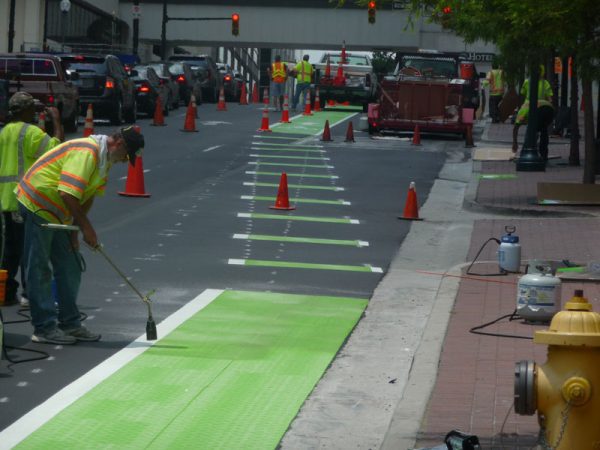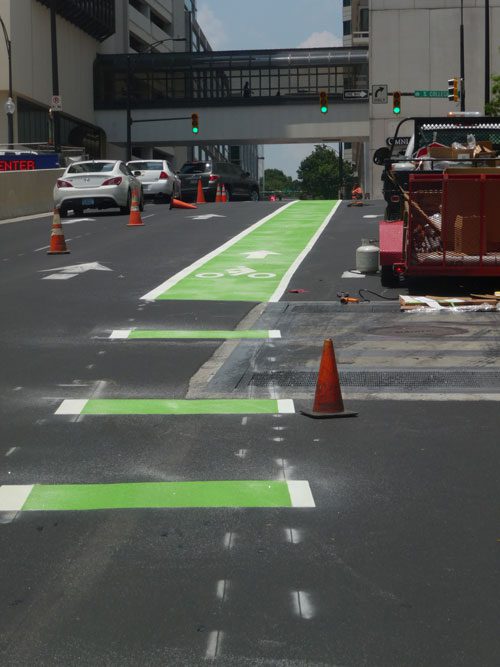Green lanes? Whatever for?

Charlotte is joining the growing ranks of cities seeking to make streets safer by turning some bicycle lanes green.
City officials hope adding green markings to existing bike lanes at certain heavily traveled intersections will more clearly, visibly and safely separate bicycles from other vehicles.
The city has installed its first green lane markings on East Fourth Street near College Street in uptown and plans to add more in select other places where cars and bicycles often can conflict.
|
More about biking design • As part of a Cities for Cycling initiative, the National Association of City Transportation Officials has an Urban Bikeway Design Guide. • See designs for “cycle tracks” in several cities. |
The markings should help cyclists see where to go and make drivers more aware of their two-wheeled counterparts, said Ken Tippette, bicycle program manager for the Charlotte Department of Transportation.
On East Fourth Street, the city’s new green lane steers cyclists between a right-turn lane and through-moving traffic so they’re to the left of the turning vehicles. A broken green pattern tells drivers where they should cross the bike lane to enter the turn lane, and a solid green portion tells cyclists where they should be safe.
“We should see a reduced amount of traffic just bolting across the bike lane,” Tippette said.
The project originated in Charlotte’s bicycle plan, which was adopted in 2008 and recommended the city look at emerging techniques such as green lanes, he said.
The city, which has secured interim approval from federal highway officials to install green lanes on city-maintained streets, is only experimenting for now.
Charlotte likely will try green lanes in at least a few more spots, in part to test different materials, Tippette said. Green lanes can be created simply with paint or by laying sheets of colored material into the street, he said.
According to a city manager’s memo, other locations being eyed are:
- Kenilworth Avenue at Charlottetowne Avenue
- East Stonewall Street from Charlottetowne Avenue to South McDowell Street
- East 10th Street at East 12th Street.
City officials plan to observe the sites before and after installation to evaluate driver and bicyclist behavior, the memo said. If green lanes work in Charlotte, they could become “just a regular, standard tool in the toolbox,” Tippette said.
“If we find they’re working well and have done no harm and maybe have made things better, we may use them more frequently,” he said.
Charlotte officials say green lanes have been used successfully in places including New York; San Francisco; St. Petersburg, Fla.; and Minneapolis. In some cities – Chicago, for example – green lanes are separated from motor traffic by plastic posts or other physical barriers, but Tippette said Charlotte’s first green lanes won’t include anything like that.
After visiting the city’s East Fourth Street green lane, Martin Zimmerman, a cycling advocate and former executive director of the Charlotte Area Bicycle Alliance, said he was pleased but would like to see longer stretches of green lanes, and perhaps even fully separated bike paths known as cycle tracks.
“This is a great start,” he said.